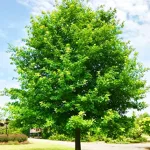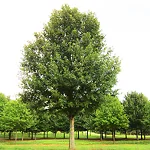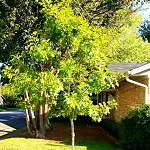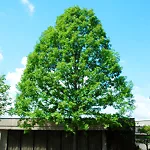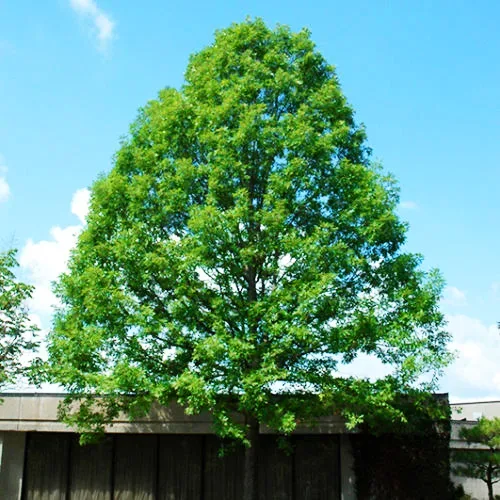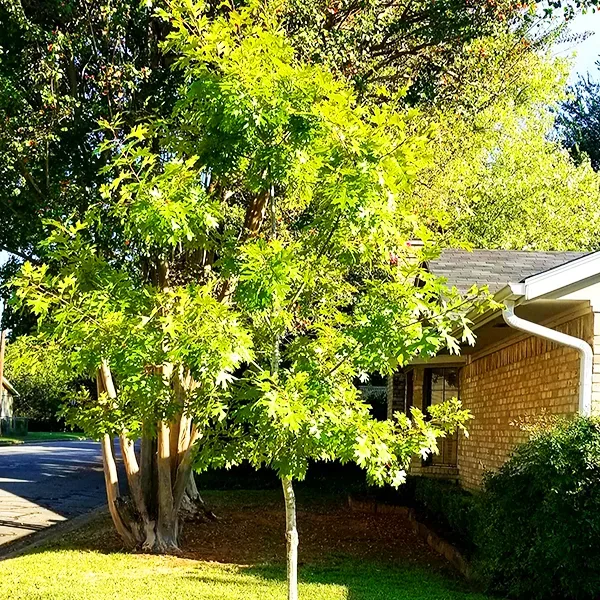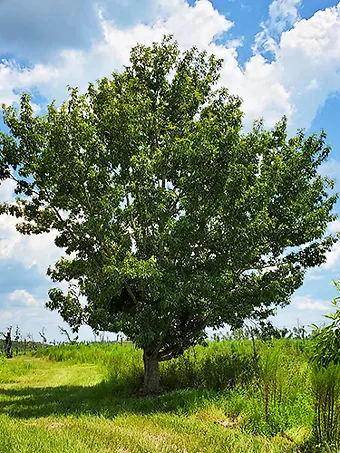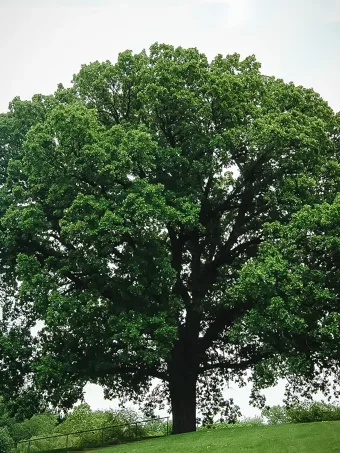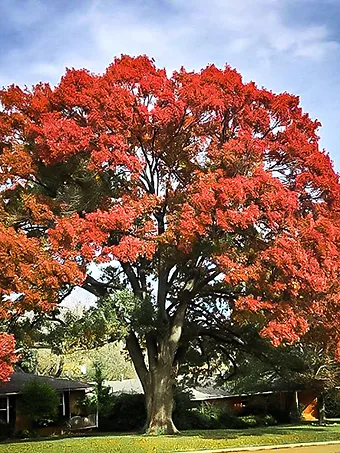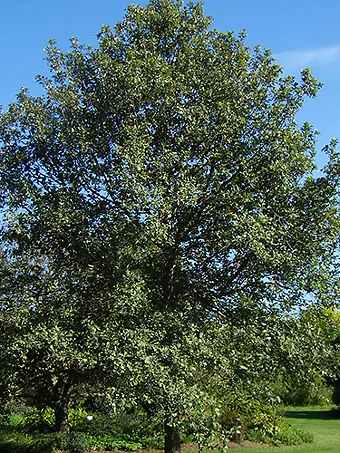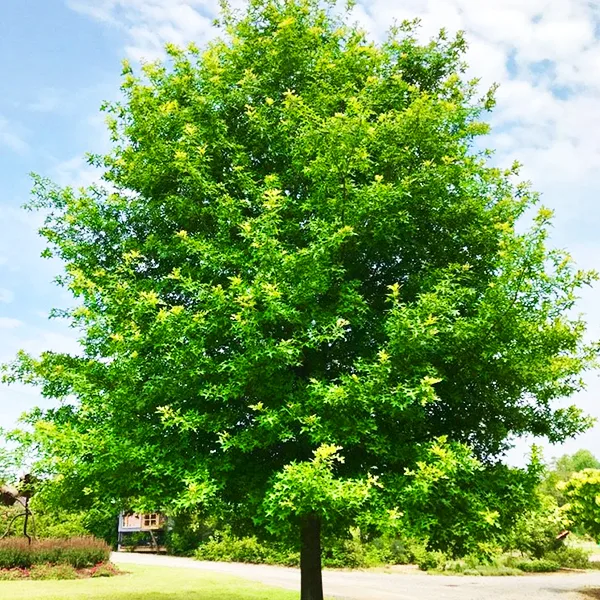
Nuttall Oak Tree
Quercus texana (= Q. nuttallii)View more from Oak Trees
Nuttall Oak Tree
Quercus texana (= Q. nuttallii)
30 day - ARRIVE AND THRIVE™ guaranteeLearn more


Special Features

Botanical Name
Quercus texana (= Q. nuttallii)
Outdoor Growing zone
5-9
Mature Height
30-75
Mature Width
25-50
Sun needs
Full Sun
Nuttall’s Oak is a superb large native oak tree, growing rapidly to 30 feet tall, and ultimately reaching 75 feet tall and 50 feet wide. It has a rugged, ridged trunk with a pyramidal crown, becoming broad and round with age. The glossy, dark-green leaves have up to 9 deep lobes, with the classic ‘oak leaf’ shape. They turn glowing shades of yellow-orange and red in fall – one of the best oaks for fall color. This is an excellent shade-tree choice for all warm and hot zones, especially in the South and Texas, but reliable almost everywhere. Grow it on a lawn, as a boundary marker, at the edge of woodland or to enrich existing natural woods. A good choice to edge a river or lake, taking occasional flooding well.
- Fast-growing native oak – adds 3 feet a year
- Large leaves with classic oak form, of glossy dark green
- Excellent fall colors of yellow-orange and red
- One of the few oaks suitable for wet ground
- Thrives in most soil, and drought resistant
Nuttall’s Oak should be planted in full sun, in just about any soil. It thrives in moist, well-drained soils, but grows well in both acidic and alkaline soils, and in heavy clays. It will grow well in wetter ground, but established trees also have excellent drought tolerance and thrive in hot, dry areas. It has no serious pests or diseases and once established is self-maintaining. Some early pruning to maintain a single leading trunk is valuable for the long-term health and appearance of the tree.
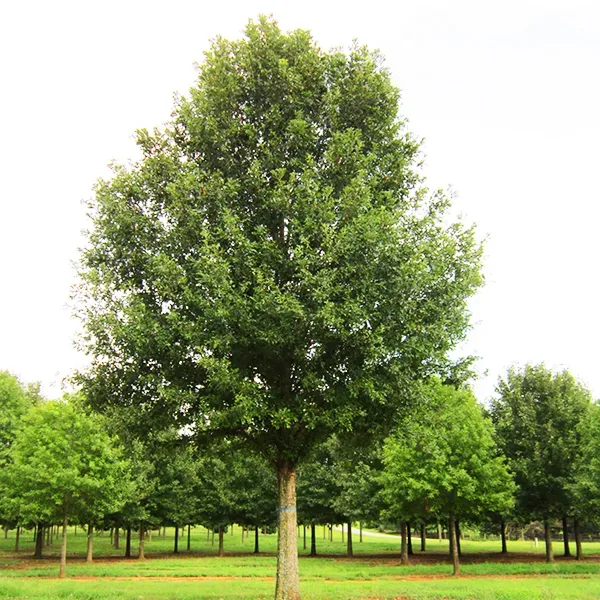
Oak trees live for a very long time, and so we tend to think of them as growing slowly. Many do, and you might quickly remove ‘oak’ from your shade-tree choices for that reason. Time to think again, but one oak is renowned for being fast-growing, and a young tree of Nuttall’s Oak will typically grow 2 or 3 feet a year, and double the diameter of its trunk every 7 years. This means that within a decade you will have a handsome 30-foot tree gracing your lawn or yard. This handsome oak tree has the classic divided oak leaves, and acorns too, and makes a terrific long-lived specimen. In time, it will reach 75 feet tall, with a spread of up to 50 feet, so allow room. It grows well in wet soils, and even recovers quickly from flooding, so if you have a wetter area in your garden, or live by a lake or river, this is a great choice. Of course it also grows in ordinary soil too, and the combination of good red fall color, spring red growth, and a handsome form, make this native oak a terrific garden tree – even if you have never heard of it before.
Growing Nuttall’s Oak
Size and Appearance
Nuttall’s Oak is a large deciduous tree, fast growing, adding 2 or 3 feet a year when young. After 10 years it will be 30 feet tall, ultimately reaching about 75 feet, with a potential spread of up to 50 feet. It has a broad, rounded crown, with branches spreading outwards. Choose your planting spot carefully, never planting beneath power lines and overhead wires, or within 25 feet of a building, wall or property line. Avoid planting over underground services, or near a swimming pool. This tree has an upright trunk, with gray-brown bark with shallow ridges and furrows, becoming darker gray as it matures, and developing deep, scaly ridges. Young trees are pyramidal, becoming more spreading and rounded as they develop.
The leaves are up to 9 inches long and 5 inches wide, and lustrous dark green, with between 5 and 9 deep, narrow lobes on each side, creating a classic ‘oak leaf’ look. In spring, especially if the season is cold, new leaves can be red to purple, quickly turning green. In all but the hottest zones fall color is reliable and attractive, with rich yellow-orange and red tones. Older trees develop acorns about 1-inch long.
Using Nuttall’s Oak in Your Garden
This tree is a terrific choice for a shade tree, growing rapidly and soon making a real statement in your garden. It is especially useful if you have wetter soil. It grows well in urban areas too, so it’s a good choice for a larger city garden – make sure you do have enough room for its mature size, as removing a large tree from a small location is a great loss, and expensive too. Since it is a native tree, Nuttall’s Oak is also a perfect choice for planting along the edge of woodlands, or improving the variety of trees in an existing wooded area.
Hardiness
Nuttall’s Oak is a tree for warm and hot parts of the country, completely hardy from zone 6 to zone 9, and also hardy in warmer parts of zone 5. It tolerates heat and humidity well.
Sun Exposure and Soil Conditions
Plant Nuttall’s Oak in full sun, or in a location where it will quickly grow into full sun. It grows in a wide range of soils, from acidic to alkaline, including heavy, wet clays. It prefers moist, well-drained soils but is also very drought resistant, once established. As well it will grow in wet soils and quickly recovers from periods of flooding. Not resistant to salt-spray or brackish water.
Maintenance and Pruning
This tree rarely suffers from either serious pests or significant diseases. It is worthwhile doing some formative pruning while the tree is young. Keep one central leading stem growing upwards, rather than allowing multiple-main branches to develop. The mature tree will be more attractive and stronger that way, even if it leaves the young tree looking thin and open for a year or two. If you want a taller trunk, remove lower branches gradually, while they are still thin, so that the trunk becomes clean and free of scars.
History and Origin of Nuttall’s Oak
Nuttall’s Oak, Quercus texana, is also called Texas oak. For a very long time it was called Quercus nuttallii, and it’s still known by that name with many nurserymen. The change of name was confusing, as there already was a different tree called Quercus texana, which is the Texas red oak. That tree is now called Quercus buckleyi.
Thomas Nuttall was an English botanist who explored and collected extensively in North America in the first half of the 19th century. He covered many areas first visited by Lewis & Clark, re-discovering plants they had found, and finding many new ones as well. His oak is found in a limited area, mostly in the lower Mississippi River Valley, Arkansas, Tennessee, Mississippi, Alabama and Louisiana. There are also scattered populations over a larger part of the east and south.
Buying Nuttall’s Oak at the Tree Center
We love being able to offer our clients more unusual plants – especially outstanding native trees like Nuttall’s Oak. These are hard to source, and always in short supply, so order yours now, sit back, and watch it grow. Seeing a tree develop before your eyes is a marvelous experience, but you need to order right away to enjoy it.
